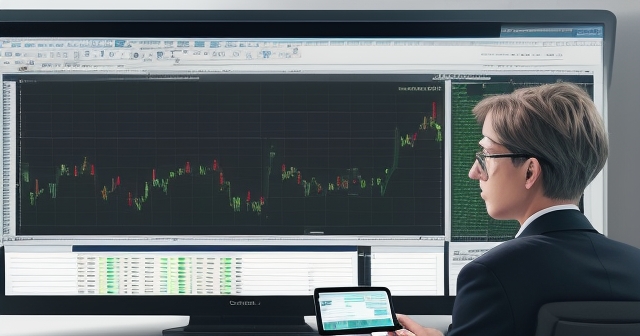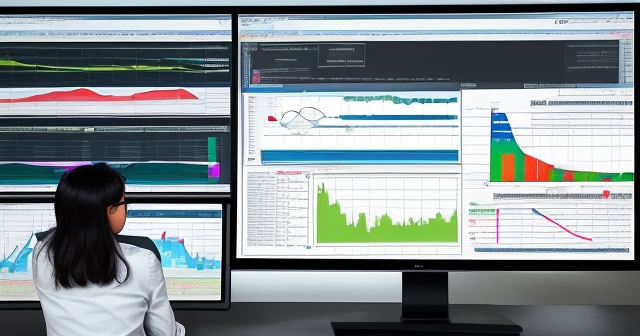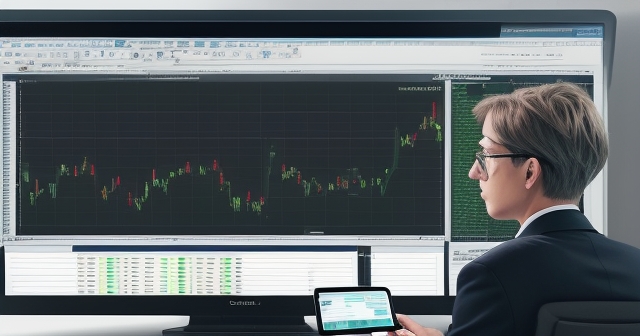Unlocking the Potential (and Perils) of CFD Trading: A Comprehensive Guide
Welcome to a deep dive into the world of Contract for Differences, or CFDs. If you’re an investor new to derivatives or a trader looking to expand your technical analysis skills into different markets, understanding CFDs is crucial. They offer intriguing possibilities but come with significant risks. Our goal is to equip you with the knowledge to navigate this complex landscape intelligently and confidently.
Think of CFD trading not as owning a piece of a company or a barrel of oil, but rather as entering into a contract with a broker based on the speculated price movement of an underlying asset. You’re essentially agreeing to exchange the difference in the asset’s price from the moment the contract is opened until it’s closed. This mechanism allows for both potential gains from rising prices (going long) and falling prices (going short).
This form of trading has gained immense popularity globally, although notably, it is restricted in the United States by the SEC due to concerns about retail investor protection. In many other major trading hubs like the UK, Australia, and across Europe and Asia, CFDs are readily available through Over-the-Counter (OTC) markets provided by brokers.
As we journey through this guide, we will break down the core concepts, explore the advantages and disadvantages, discuss the associated costs and risks, and place CFD trading within the broader context of global financial markets and economic events. Are you ready to explore this powerful, yet challenging, financial product?

At its heart, a CFD is a derivative product. This means its value is derived from the performance of an underlying asset. When you trade a CFD, you aren’t buying shares in Apple, a contract for a barrel of Brent crude, or a position in the EUR/USD currency pair directly on a traditional exchange.
Instead, you enter into an agreement with a CFD provider (your broker). The contract stipulates that if the price of the underlying asset increases, the seller (usually the broker) pays the buyer the difference. If the price decreases, the buyer pays the seller the difference. This simple concept is what allows you to potentially profit from both uptrends and downtrends in the market.
Let’s consider an example. Suppose the price of Gold is $2,000 per ounce. You believe the price will rise, so you buy a 1-ounce CFD contract on Gold from your broker. If the price subsequently rises to $2,010 and you close the contract, the price has moved $10 in your favor. Your broker pays you the $10 difference (minus any costs, which we’ll discuss later). Conversely, if the price fell to $1,990, you would pay your broker the $10 difference.
This mechanism applies across a wide range of markets: Forex pairs like EUR/USD, major indices like the Nasdaq 100 or FTSE 100, commodities like WTI crude, and individual company shares.
A key aspect is the ability to easily take a short position. If you anticipate a price decline, you can ‘sell’ a CFD. Using the Gold example, if you sold a 1-ounce contract at $2,000 and the price dropped to $1,990, you could buy it back (close the short position) and pocket the $10 difference. This flexibility is a major draw for active traders.
| Market Type | Description |
|---|---|
| Forex | The largest financial market globally; it’s open 24/5 and involves trading currency pairs. |
| Indices | Speculates on baskets of companies’ performance, protecting against the volatility of individual stocks. |
| Commodities | Involves trading raw materials such as gold, silver, and crude oil; highly influenced by global events. |
| Shares | Allows speculation on individual company stock prices, similar to direct share trading. |
One of the most defining characteristics of CFD trading is the use of leverage. Leverage allows you to control a large position in the market with a relatively small amount of capital. The capital you put up is known as the margin.
Imagine a leverage ratio of 100:1. This means for every $1 of your own capital (margin), you can control $100 worth of the underlying asset. So, to open a $10,000 position, you might only need to deposit $100 as margin.
This is where the power lies: potential profits are calculated on the full value of the position ($10,000 in this case), not just your margin ($100). If the asset’s price moves favorably by 1%, that’s a $100 gain on the $10,000 position. On your initial $100 margin, that’s a 100% return! Sounds incredible, doesn’t it?
But this is the “double-edged sword” aspect. Leverage magnifies losses just as effectively as it magnifies gains. If the asset’s price moves against you by just 1%, you lose $100 on the $10,000 position. This loss wipes out your entire initial $100 margin. You could lose your entire deposit very quickly, and potentially more than your deposit if the market moves sharply against you and you don’t have sufficient funds to cover the losses.

Brokers impose a maintenance margin requirement. If the market moves against your open position and your account equity falls below a certain level, your broker will issue a margin call, asking you to deposit additional funds. If you fail to meet the margin call, the broker has the right to close your position automatically to limit further losses. This can often happen at unfavorable prices in volatile markets.
Understanding leverage is not just about the potential for high returns; it’s fundamentally about managing significantly amplified risk. The higher the leverage offered, the greater the risk you are taking with your capital.
A significant advantage of CFD trading is the sheer breadth of markets and financial instruments you can access from a single trading platform provided by your broker. Unlike traditional trading where you might need separate accounts for stocks, Forex, or commodities, CFDs consolidate access.
Here’s a breakdown of the major categories of underlying assets you can typically trade via CFDs, drawing from the types mentioned in our data:
-
Forex (Foreign Exchange): The largest financial market globally. Trade major currency pairs like EUR/USD, USD/JPY, GBP/USD, and AUD/USD, as well as minor and exotic pairs. Forex markets are open 24/5, offering constant trading opportunities based on global economic and political events.
If you’re considering starting Forex trading or exploring more CFD instruments, then Moneta Markets is a platform worth considering. It’s from Australia and offers over 1000 financial instruments, suitable for both beginners and professional traders.
-
Indices: Trade major stock market indices representing baskets of top companies from specific countries or sectors. Examples include the Nasdaq 100 (US tech), FTSE 100 (UK large caps), S&P 500 (US large caps), and the Nikkei (Japan). Trading indices allows you to speculate on the overall health or direction of a particular stock market without analyzing individual companies.
-
Commodities: Gain exposure to the price movements of raw materials. This includes metals like Gold and Silver, energies like WTI crude and Brent crude, and agricultural products. Commodity prices are often influenced by supply and demand dynamics, geopolitical events, and economic growth forecasts.
-
Shares (Stocks): Trade CFDs on individual company stocks listed on major exchanges worldwide. While you don’t own the shares, you can speculate on their price changes. This is often where commissions apply, unlike spread-only pricing on many other CFD types.
-
Other Instruments: Some brokers also offer CFDs on sectors (e.g., banking, technology), bonds (like Treasury yields), and even cryptocurrencies (though the regulatory landscape for crypto CFDs varies significantly by region).
| Instrument Type | Description |
|---|---|
| Forex | Trading major and exotic currency pairs in a 24/5 market. |
| Indices | Speculating on stock market baskets without trading individual stocks. |
| Commodities | Trading raw materials like metals and energy products, influenced by global factors. |
| Shares | Speculating on individual stock prices without ownership or dividends. |
Beyond the access to global markets and the mechanism of speculating on price movement, CFD trading offers several advantages that attract active traders. However, it’s vital to weigh these against the significant risks we’ve already touched upon and will delve into further.
Here are some key benefits often cited:
-
Leverage Opportunities (with caution): As discussed, leverage allows for larger positions with less capital. While highly risky, for experienced traders with robust risk management, it can amplify potential returns on relatively small price changes. However, this requires extreme discipline.
-
Go Long or Short Easily: The ability to profit from falling prices (shorting) is just as straightforward as profiting from rising prices (going long). This makes CFDs versatile in various market conditions, whether bullish or bearish. Unlike shorting stocks conventionally, you don’t need to borrow shares, potentially avoiding associated costs or complexities.
-
Broad Market Access from One Platform: Access Forex, indices, commodities, and shares through a single account and trading platform, simplifying portfolio management and allowing traders to quickly pivot between different markets based on opportunities.
-
Professional Execution Potential: Many CFD brokers offer advanced trading platforms with tools for technical analysis, charting packages, and various order types (like stop orders, limit orders, OCO orders) that are essential for implementing trading strategies and managing risk.
-
No Day Trading Restrictions (in many regions): Unlike some regulations in other markets (like the US Pattern Day Trader rule), CFD trading in regions like the UK, Australia, and Europe generally doesn’t impose specific capital requirements or limits on the number of trades executed within a day.
-
Lower Initial Capital Requirement: Due to leverage, the initial margin required to open a CFD position is significantly lower than buying the underlying asset outright. This makes larger market exposure accessible to traders with less capital.
| Advantage | Description |
|---|---|
| Leverage Opportunities | Control large positions with minimal capital, resulting in amplified returns. |
| Profit from Both Directions | Ability to trade both rising and falling markets easily. |
| Single Platform Access | Trade multiple asset classes from one account, streamlining management. |
| Advanced Trading Tools | Access sophisticated platforms with analytical tools for informed trading. |
Now, let’s confront the most critical aspect of CFD trading: the inherent disadvantages and the profound risks involved. While the potential for profit exists, it’s overshadowed by the very real and often high likelihood of loss, particularly for retail traders.
You must internalize this fact: a substantial percentage of retail client accounts lose money when trading CFDs. Industry disclosures often cite figures around 71% or even higher. This isn’t a casual warning; it’s a statistical reality based on actual trading outcomes. Why is this the case?
-
Amplified Losses Due to Leverage: This is the primary reason for significant losses. As we discussed, leverage magnifies unfavorable price movements just as much as favorable ones. A small market move against your position can lead to a margin call or even wipe out your entire account balance rapidly.
-
Immediate Loss Upon Entry (The Spread): Every CFD trade begins with an immediate cost: the spread. This is the difference between the buy (ask) price and the sell (bid) price offered by the broker. As soon as you open a position, it will show a small loss equal to the spread. For your trade to become profitable, the market price must move past the spread in your favor.
-
Margin Calls: If the market moves against your leveraged position, your broker will require additional funds (a margin call) to maintain the required margin level. Failing to meet a margin call will result in your position being automatically closed, potentially at a significant loss, regardless of whether the market might have later reversed in your favor.
-
Counterparty Risk: CFD trading is an OTC product, meaning it’s a contract directly between you and your broker, not a trade on a regulated exchange. While reputable, regulated brokers mitigate this, you are exposed to the financial stability of your broker. In rare cases of broker insolvency, recovering funds could be challenging depending on regulatory protections.
-
Liquidity Issues: While major markets like Forex and indices are highly liquid, CFDs on smaller or less popular shares or commodities might experience lower liquidity. This can result in wider spreads and difficulty executing trades at your desired price, especially in volatile conditions.
-
Complexity: CFDs are sophisticated financial products. Understanding leverage, margin, spreads, financing charges, and how global events impact various markets requires significant education and practice. It’s easy to underestimate the complexity.
| Risk Factor | Explanation |
|---|---|
| Leverage | Magnifies both gains and losses, leading to rapid account depletion. |
| Immediate Cost | Spreads create initial losses, requiring significant price movement to profit. |
| Margin Calls | Can lead to automatic position closure, resulting in losses. |
| Counterparty Risk | Exposure to broker’s financial stability and potential insolvency issues. |
Successful trading isn’t just about predicting price movement; it’s also about managing your costs. With CFD trading, several types of costs can impact your overall profitability. Being aware of these is essential for calculating potential outcomes and managing expectations.
The primary costs you will encounter are:
-
The Spread: This is the most common cost. As mentioned, it’s the difference between the buy (ask) price and the sell (bid) price. The spread is essentially the broker’s fee for facilitating the trade. For popular instruments like major Forex pairs or indices, spreads are typically tight (small), often just a few “pips” or points. For less liquid instruments, spreads can be wider. The cost of the spread is paid at the moment you open the trade.
-
Commission: While many CFDs (especially Forex and indices) are traded commission-free with the cost built into the spread, CFD trading on individual shares often involves a separate commission fee. This is usually a percentage of the trade value or a fixed amount per share, similar to traditional stock trading. Check your broker’s fee structure carefully, as this can vary significantly.
-
Financing Charges (Overnight Swaps): This is a cost (or sometimes a small credit) applied to positions held open overnight. It’s essentially an interest payment. If you hold a long position, you typically pay a financing charge based on the value of the position and relevant interbank interest rates. If you hold a short position, you might either pay a smaller charge or potentially receive a small credit, depending on interest rate differentials and broker policy. These charges can accumulate significantly over time, making CFDs less suitable for very long-term position holding compared to direct asset ownership.
-
Other Potential Fees: Be aware of potential inactivity fees (if you don’t trade for a long period), withdrawal fees, or currency conversion fees if your account base currency is different from the instrument you are trading.
These costs directly impact your profit potential. A winning trade must exceed the total costs incurred (spread + commission + financing) to generate a net profit. Understanding and factoring these costs into your trading plan is a hallmark of an experienced trader.
The availability and regulation of CFD trading vary significantly across the globe. Understanding these differences is crucial before you begin trading.
Most notably, CFD trading is prohibited in the United States. The Securities and Exchange Commission (SEC) views them as high-risk, leveraged products and has banned their sale to retail investors within the US. So, if you are based in the US, you cannot legally trade CFDs with a US-regulated broker.
However, CFDs are widely available in many other parts of the world, including:
- United Kingdom (UK)
- Australia
- Across much of Europe (including Germany, France, Spain, Italy, Switzerland, etc.)
- Canada (though sometimes with restrictions or variations)
- South Africa
- Singapore
- Many countries in the APAC region
- Other countries like New Zealand, Sweden, Norway, Denmark, Netherlands, Belgium, Thailand, Hong Kong.
Regulatory bodies in these regions (such as the Financial Conduct Authority (FCA) in the UK, the Australian Securities and Investments Commission (ASIC) in Australia, and similar bodies in Europe and elsewhere) oversee CFD brokers. Their regulations often focus on ensuring brokers are adequately capitalized, segregate client funds, provide clear risk warnings (like the percentage of retail clients who lose money), and in recent years, have implemented measures to protect retail investors, such as:
- Setting limits on the maximum leverage offered to retail clients (e.g., 30:1 for major Forex pairs in the UK/Europe, lower for less volatile assets).
- Mandating margin close-out rules to prevent accounts from going into a negative balance (Negative Balance Protection).
- Requiring standardized risk warnings to be prominently displayed.

When choosing a broker, verifying their regulatory status and ensuring they are licensed in your jurisdiction or a reputable one is paramount for fund security and fair trading practices. For instance, many well-regarded brokers hold licenses from multiple authorities like FSCA, ASIC, or FSA, providing layers of oversight.
Trading CFDs effectively requires more than just understanding the mechanics; it demands a solid grasp of market analysis and execution. Whether you lean towards technical or fundamental analysis, these skills are directly applicable to speculating on the price movement of the underlying assets tradable via CFDs.
-
Technical Analysis: Many CFD traders rely heavily on technical analysis, studying historical price charts, patterns, and indicators to forecast future price movements. Concepts like support and resistance levels, trend lines, moving averages, and oscillators (like RSI or MACD) are used to identify potential entry and exit points for CFD trades. Given the prevalence of short-term trading in CFDs, the ability to quickly identify trading signals is often key.
-
Fundamental Analysis: For instruments like Forex, indices, and commodities, fundamental analysis is equally important. This involves analyzing economic indicators (like CPI or PMI data), central bank decisions (from the Fed, BOE, BOJ, etc.), geopolitical events, and earnings reports (for individual stock CFDs). These factors drive the supply and demand dynamics that cause price changes. Understanding the impact of a major economic announcement can provide valuable insights for CFD trading decisions.
| Order Type | Description |
|---|---|
| Market Order | Execute your trade immediately at the best available current price. |
| Limit Order | Place an order to buy or sell at a specific price or better. |
| Stop Order | Place an order to buy or sell once the market reaches a specific price. |
| Trailing Stop Order | Lock in profits while providing protection against reversals. |
| OCO (One Cancels the Other) Order | A pair of orders where if one executes, the other is canceled. |
As CFD traders, you are speculating on the price movement of assets that are constantly reacting to the pulse of the global economy and significant events. Ignoring macroeconomics and news releases is like trying to sail without checking the weather forecast.
Consider the assets you trade via CFDs: Forex pairs are direct reflections of the relative economic health and monetary policy expectations between two countries. Indices represent the collective sentiment and performance of companies within an economy. Commodities are impacted by global demand, supply shocks, and geopolitical stability.
Key economic events and data releases that significantly impact CFD markets include:
-
Central Bank Announcements: Decisions and statements from major central banks like the U.S. Federal Reserve (FOMC meetings), European Central Bank (ECB), Bank of England (BOE), Bank of Japan (BOJ), Reserve Bank of Australia (RBA), and Swiss National Bank (SNB) are massive market movers. Interest rate decisions, quantitative easing/tightening policies, and forward guidance on the economy directly influence currency values, bond yields (impacting indices), and sometimes even commodity prices.
-
Inflation Data (e.g., CPI): Consumer Price Index (CPI) releases are closely watched as they are key indicators of inflation. High inflation can pressure central banks to raise interest rates, impacting Forex and bond markets, and subsequently indices. Low inflation or deflation can signal economic weakness.
-
Employment Data: Reports like non-farm payrolls in the US are major indicators of economic health and labor market strength, heavily influencing Forex and stock indices.
-
PMI Data: Purchasing Managers’ Index (PMI) surveys provide insights into the health of manufacturing and services sectors. Strong PMI data suggests economic expansion, potentially boosting indices and currencies.
-
Geopolitical Events: Wars, political instability (like French political tensions mentioned in the data), trade disputes, and major elections can introduce significant volatility and uncertainty into global markets, causing sharp price movements across various CFD instruments.
-
Earnings Reports: For individual stock CFDs, company earnings reports are pivotal events that can lead to large price gaps and rapid movement after release.

Choosing the right CFD broker is a critical step in your trading journey. Your broker is your gateway to the markets and provides the platform you will use to execute trades. The quality of their services, fees, and regulatory standing can significantly impact your trading experience and potential for success.
Here are key factors to consider when choosing a CFD broker:
-
Regulation: Is the broker regulated by a reputable financial authority in a major jurisdiction (e.g., ASIC, FCA, FSCA)? Regulatory oversight provides a layer of protection, ensuring the broker adheres to strict financial standards and client money rules. Avoid unregulated brokers at all costs.
-
Trading Platform: Does the broker offer a stable, user-friendly, and feature-rich trading platform? Popular platforms like MT4 and MT5 are industry standards, offering advanced charting tools, indicators, and automated trading capabilities. Some brokers also offer their own proprietary platforms (like Pro Trader), which might have unique features.
When choosing a trading platform, Moneta Markets‘ flexibility and technological advantages are worth noting. It supports mainstream platforms like MT4, MT5, and Pro Trader, combining high-speed execution with low spread settings to provide a good trading experience.
-
Available Instruments: Does the broker offer CFDs on the specific markets and assets you are interested in trading (Forex, indices, commodities, shares, etc.)?
-
Spreads and Commissions: Compare the costs across different brokers. Look for competitive spreads, especially on the instruments you trade most frequently. Be aware of commission structures for share CFDs and financing charges for overnight positions.
-
Execution Speed: How quickly and reliably are your orders executed? Slippage (the difference between your requested price and the actual execution price) can be a significant factor, especially in volatile markets.
-
Customer Service: Is customer support readily available, responsive, and helpful? This can be crucial when you encounter technical issues or have questions about your account.
-
Funding and Withdrawal Options: Ensure the broker offers convenient and secure methods for depositing and withdrawing funds, and be aware of any associated fees or processing times.
-
Educational Resources: Does the broker provide educational materials, webinars, or analysis to help you improve your trading skills and market understanding? Knowledge-based brands often excel in this area.
Taking the time to research and choose a reliable, well-regulated broker with a platform that suits your needs is a fundamental step towards trading CFDs responsibly.
Conclusion: Navigating the CFD Landscape Responsibly
We’ve covered a significant amount of ground, from defining what CFDs are and how they work to exploring their potential advantages, confronting their substantial risks, breaking down the costs, and understanding their place in the global market ecosystem. Our journey has aimed to provide you with a solid educational foundation, embodying the principles of experience, expertise, authority, and trustworthiness.
CFDs are powerful financial instruments that offer leveraged exposure to a vast array of global markets, allowing traders to speculate on price movement in both rising and falling environments. The accessibility and flexibility they provide are undeniable benefits for active traders.
However, the message that must resonate above all others is the inherent high risk. The amplified nature of leverage means that while potential gains are magnified, so too are potential losses. The statistic that a high percentage of retail client accounts lose money trading CFDs serves as a stark reminder of the challenges involved.
Success in CFD trading is not guaranteed and requires dedication. It demands a deep understanding of the product mechanics, diligent risk management, continuous learning about market analysis (both technical and fundamental), awareness of global economic events, and discipline in execution. It also necessitates choosing a reputable, well-regulated broker.
CFD trading is not suitable for everyone, particularly individuals who are not comfortable with high levels of risk or who do not have a thorough understanding of leveraged products. You could lose your entire invested capital.
Before you decide to trade CFDs, ask yourself:
- Do I fully understand how leverage works and its potential impact on my capital?
- Have I accounted for all the costs, including spreads, commissions, and financing charges?
- Do I have a clear trading plan and a robust risk management strategy, including using stop-loss orders?
- Am I trading with capital I can afford to lose?
- Have I chosen a well-regulated broker and tested their platform?
Approach CFD trading with respect for the risk involved, prioritize education and practice (perhaps starting with a demo account), and always trade responsibly. By doing so, you position yourself to navigate this challenging yet potentially rewarding corner of the financial markets with greater awareness and control.
trading de cfdFAQ
Q:What are CFDs?
A:CFDs are contracts between a trader and a broker to exchange the difference in value of an underlying asset from the time the contract is opened until it is closed.
Q:What is leverage in CFD trading?
A:Leverage allows traders to control larger positions than their initial capital would permit. For example, with 100:1 leverage, a $100 investment can control a $10,000 position.
Q:Are there risks involved in CFD trading?
A:Yes, CFD trading carries significant risks including potential losses greater than your initial investment, especially due to the use of leverage.

留言